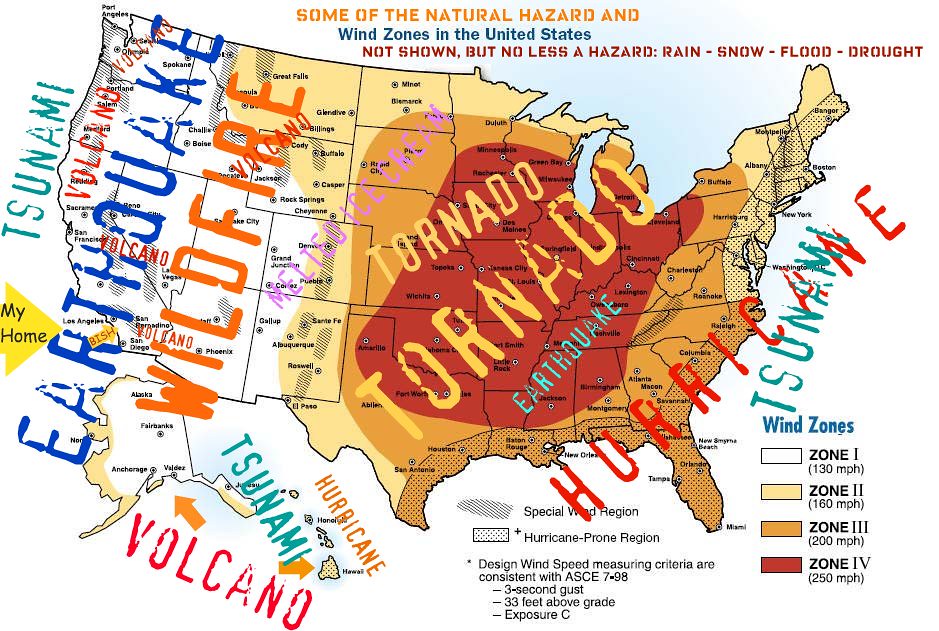
Title Page
Tornadoes
Written for: Earth Science 2013
by: Mr Willits
Tornadoes
Tornadoes are violently rotating clouds of air that come into contact with the ground. Tornadoes develop from a special type of cloud called a funnel cloud and will develop a swirling tail that will get closer and closer to the ground The spiraling wids will rotate in speeds over 100 mph and cause vast destruction upon reaching the ground. Most tornadoes are associated with thunderstorms and the immediate oncoming of a cold front during warmer months of the season.

Where do tornadoes frequently occur?
Tornadoes frequently occur in the Midwestern United States in what is commonly referred to as Tornado Alley. Tornado Alley stretches across the midwest ranging from Oklahoma to Illinois.

On the map above you can see that Tornado Alley stretches across the midwest and is pretty much relocated to this area. It is very important for us to understand as much information as we can about this natural disaster as we are living in this region.
Tornado season is generally from late spring to summer as this is prime conditions for the thunderstorms needed to produce this devastating disaster.
Last Major Tornado
Oklahoma 2013:
The last major tornado to affect the United States was in Oklahoma in the spring of 2013. The tornado was a registered F-5 and did damage across a wide area. There were approximately 50 deaths while over 350 were injured. The estimated amound of damage was around 2 billion dollars. Located below are a couple of links to articles and pictures of the devastating earthquake that swept through Oklahoma on this late spring day. The stories from this national disaster are extremely tragic and let's us know that tornadoes are nothing to be messed with.
The devastation in Moore, Oklahoma is still being felt today as many people's lives changed forever that day. Tornadoes truly are terrible disasters to occur and sometimes it takes a very long time for communities to heal.

Scientific Steps
We rely heavily on the information that meteorologists present to us. The weathermen are going to utilize a device called a Doppler Radar. They utilize this radar to detect the ways the weather is moving and general information about the current weather coniditions. The Doppler Radar information then is presented to the public of the general area and it can be placed under Tornado Warning or Watch. The difference between a watch and a warning is that during a warning the piece of weather is actively occurring.
There is also a group of people who are chasing these storms to try to capture photos that will better understand how tornadoes work. The chases may use homemad device that are sucked up and released within a tornado to get a better idea of the internal conditions within a tornado.

Tornado Safety
Before a Tornado:
- Be prepared
- Take shelter in an enclosed area with no windows preferably in a basemant or cellar.
- Have blankets, pillows, and something to cover yourself with.
- Do not go outside.
- Do not look out a window
During a Tornado:
- Stay calm and understand it will pass relatively quickly.
- Do not think the condition has passed until you are completely safe for over 2 minutes.
- Keep your head covered.
After a Tornado:
- Be safe and be cautious.
- Check yourself and whoever you are with for injuries.
- Do not flood 9-1-1 with phone calls
- Do not touch downed power lines and try to remain in safe areas.

Images




Works Cited
"About Mile Wide Tornado: Oklahoma Disaster".Discovery. Retrieved November 8, 2013.
Finocchiaro, P. (2013, May 20). Oklahoma Tornado 2013 Devastates Moore, Kills Dozens (GRAPHIC PHOTOS). The Huffington Post. Retrieved November 8, 2013, from http://www.huffingtonpost.com/2013/05/20/oklahoma-tornado-2013_n_3309844.html
NOAA National Severe Storms Laboratory. (n.d.). NSSL: Severe Weather 101: Tornado Detection. Retrieved November 8, 2013, from http://www.nssl.noaa.gov/education/svrwx101/tornadoes/detection/
Tornado devastates Moore, Oklahoma. (n.d.). CNN. Retrieved November 11, 2013, from http://www.cnn.com/interactive/2013/05/us/moore-oklahoma-tornado/
United States. (n.d.). AccuWeather. Retrieved November 8, 2013, from http://www.accuweather.com/en/weather-news/the-difference-between-tornado/61817
All images courtesy of Flickr and copyright free.
Other information is through lecture/notes therefore no citation is needed.
Imprint
Publication Date: 11-11-2013
All Rights Reserved